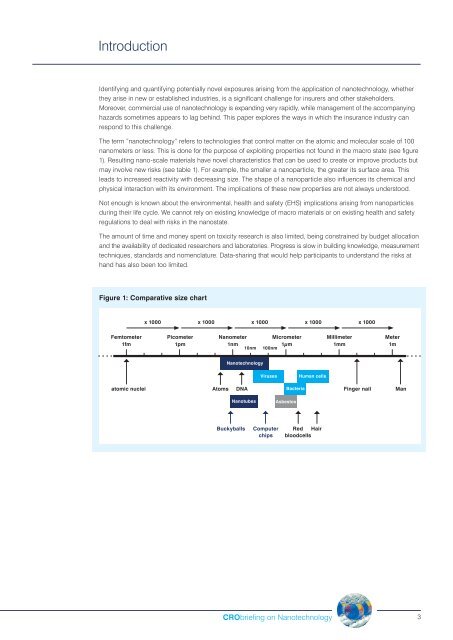Nanotechnology - Nanowerk
Nanotechnology - Nanowerk
Nanotechnology - Nanowerk
Create successful ePaper yourself
Turn your PDF publications into a flip-book with our unique Google optimized e-Paper software.
Introduction<br />
Identifying and quantifying potentially novel exposures arising from the application of nanotechnology, whether<br />
they arise in new or established industries, is a significant challenge for insurers and other stakeholders.<br />
Moreover, commercial use of nanotechnology is expanding very rapidly, while management of the accompanying<br />
hazards sometimes appears to lag behind. This paper explores the ways in which the insurance industry can<br />
respond to this challenge.<br />
The term “nanotechnology” refers to technologies that control matter on the atomic and molecular scale of 100<br />
nanometers or less. This is done for the purpose of exploiting properties not found in the macro state (see figure<br />
1). Resulting nano-scale materials have novel characteristics that can be used to create or improve products but<br />
may involve new risks (see table 1). For example, the smaller a nanoparticle, the greater its surface area. This<br />
leads to increased reactivity with decreasing size. The shape of a nanoparticle also influences its chemical and<br />
physical interaction with its environment. The implications of these new properties are not always understood.<br />
Not enough is known about the environmental, health and safety (EHS) implications arising from nanoparticles<br />
during their life cycle. We cannot rely on existing knowledge of macro materials or on existing health and safety<br />
regulations to deal with risks in the nanostate.<br />
The amount of time and money spent on toxicity research is also limited, being constrained by budget allocation<br />
and the availability of dedicated researchers and laboratories. Progress is slow in building knowledge, measurement<br />
techniques, standards and nomenclature. Data-sharing that would help participants to understand the risks at<br />
hand has also been too limited.<br />
Figure 1: Comparative size chart<br />
x 1000 x 1000 x 1000 x 1000 x 1000<br />
Femtometer<br />
1fm<br />
Picometer<br />
1pm<br />
Nanometer<br />
1nm<br />
10nm<br />
Micrometer<br />
1µm<br />
100nm<br />
Millimeter<br />
1mm<br />
Meter<br />
1m<br />
<strong>Nanotechnology</strong><br />
Viruses<br />
Human cells<br />
atomic nuclei Atoms DNA<br />
Bacteria<br />
Finger nail<br />
Man<br />
Nanotubes<br />
Asbestos<br />
Buckyballs<br />
Computer<br />
chips<br />
Red Hair<br />
bloodcells<br />
CRObriefing on <strong>Nanotechnology</strong><br />
3<br />
_013ZC_131887A01.indd 3 03/11/2010 10:38
















